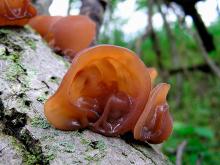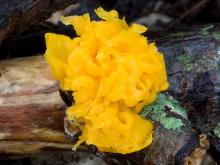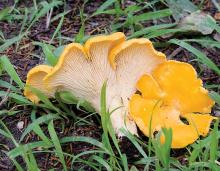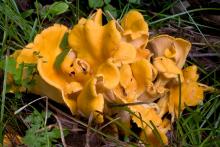Mushrooms
Media

Species Types
Scientific Name
Auricularia auricula (formerly A. auricula-judae)
Description
The wood ear is a reddish brown to grayish black, rubbery, earlike or cup-shaped mushroom. It usually grows in groups on rotting wood.
Media

Species Types
Scientific Name
Exidia alba (Ductifera pululahuana)
Description
Pale jelly roll is a small, white, gelatinous fungus with an irregular shape. It looks like a brain, or like jelly — or both! It grows in clusters on dead wood of deciduous trees.
Media

Species Types
Scientific Name
Tremella mesenterica
Description
Witches' butter is a fungus that looks like small, yellow, irregularly lobed, gelatinous masses. It grows on dead deciduous wood, especially oaks.
Media

Species Types
Scientific Name
Morchella angusticeps (formerly M. elata)
Description
The black morel is a prized edible mushroom. It has a honeycombed cap with black to brownish black ridges and yellowish brown pits. It is completely hollow and grows in the spring.
Media

Species Types
Scientific Name
Cantharellus cibarius
Description
Golden chanterelles have a bright orange to yellow cap with wavy margins; beneath, they're orange-yellow, with forked ridges (not true gills) descending the stalk. They grow in soil.
Media

Species Types
Scientific Name
Cantharellaceae (various members of family)
Description
Chanterelles are funnel- or trumpet-shaped and have wavy cap edges. Most are bright orange or yellow, although one, the black trumpet, is brownish black.
Media

Species Types
Scientific Name
Desarmillaria caespitosa (formerly Armillaria tabescens)
Description
The ringless honey mushroom is honey-colored, with a dry, scaly cap, and lacks a ring on the stalk. It grows in clusters at the bases of trees or stumps, especially of oaks, and over buried wood.
Media

Species Types
Scientific Name
Agaricus campestris
Description
The meadow mushroom has a smooth white to light grayish cap and pinkish brown gills. It's found in lawns and other grassy areas.
Media

Species Types
Scientific Name
Amanita onusta
Description
The onusta amanita has a grayish white cap with grayish brown warts that are often erect, and a long stalk with grayish brown warts. It grows on the ground in mixed woods.
Media

Species Types
Scientific Name
Coprinellus micaceus (formerly Coprinus micaceus)
Description
The mica cap has a bell-shaped, tawny brown, radially lined cap and inky gills. It grows in clusters around stumps or on wood debris.
See Also



Media

Species Types
Scientific Name
Monotropa hypopitys
Description
Pinesap is a plant that puts the "wild" in wildflower! It lacks chlorophyll, so its roots connect to fungi underground and absorb nutrients from the fungi.
Media

Species Types
Scientific Name
Cladophora, Pithophora, and Spirogyra spp., and others
Description
Filamentous green algae forms green, cottony masses that are free-floating or attached to rocks, debris, or other plants.
Media

Species Types
Scientific Name
Monotropa uniflora
Description
Indian pipe lacks chlorophyll, so it is white, not green. Below ground, its roots join with fungi that connect to tree roots. This plant, then, takes nourishment indirectly from the trees.
About Mushrooms in Missouri
Mushrooms are a lot like plants, but they lack chlorophyll and have to take nutrients from other materials. Mushrooms are neither plants nor animals. They are in a different kingdom — the fungi. Fungi include the familiar mushroom-forming species, plus the yeasts, molds, smuts, and rusts.
Always be cautious when eating edible mushrooms. Be absolutely sure of the ID, and only eat a small amount the first time you try it to avoid a reaction..





















